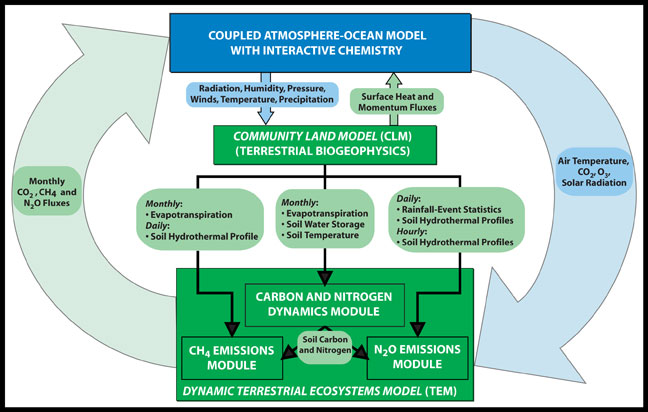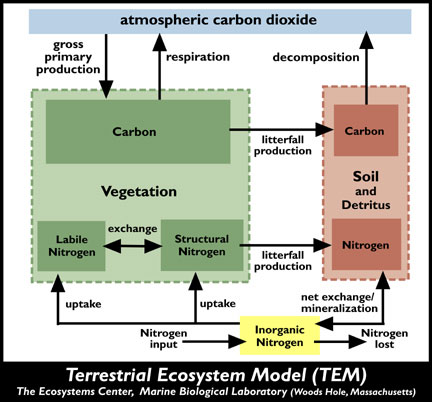
| Home | Publications | Personnel | Models | Outreach | Structure | SEARCH |
 |
| Home | Publications | Personnel | Models | Outreach | Structure | SEARCH | |
The MIT Integrated Global System Model: Ecosystems Impacts
Changes in terrestrial ecosystems due to changes in climate are an important consideration in policy discussions. But climate-driven changes in the terrestrial biosphere also affect climate dynamics, through feedbacks on both the carbon cycle and the natural emissions of trace gases.

TEM has been used with the IGSM to examine the responses of terrestrial ecosystems to climate change, enhanced atmospheric CO2 concentrations, nitrogen availability and land-use change. And changes in natural ecosystems, as predicted by TEM, are used as a measure of terrestrial effects, or as inputs to analysis of the impact of climate change on agriculture. The version of TEM currently used in the IGSM also incorporates the influence of ozone on plant productivity and the influence of soil thermal regime on terrestrial carbon and nitrogen dynamics.

TEM is a process-based ecosystem model that simulates important carbon and nitrogen fluxes and pools for 18 terrestrial ecosystems. It runs at a monthly time step. Driving variables include monthly average climate (precipitation, mean temperature and mean cloudiness), soil texture (sand, clay and silt proportion), elevation, vegetation and water availability. The model incorporates a water balance model to generate hydrological input (e.g., potential evapotranspiration, soil moisture). For global extrapolation, TEM uses spatially-explicit data sets at a resolution of 0.5 degrees. The global data sets include long-term average climate, potential natural vegetation, soil texture and elevation.
Utilizing the IGSM's climate predictions, TEM generates predictions of natural ecosystems states, including land vegetation changes, land CO2 fluxes, and soil composition, which feed back to the coupled chemistry/climate, and natural emissions models. The representations of ecosystem change produced by TEM are a crucial link to the estimation of economic and ecological effects. The change in carbon and nitrogen fluxes, and in carbon storage in vegetation and soils, are themselves useful indicators of climate change impact, and they provide a key step in the estimation of more specific models of effects on agriculture and natural ecosystems. With these linked components, the IGSM is used to study how climate-driven changes in the terrestrial biosphere affect climate dynamics through feedbacks on both the carbon cycle and the natural emissions of trace gases.
The Natural Emissions Model (NEM) is used to simulate the emissions of methane (CH4) and nitrous oxide (N2O) from the terrestrial biosphere to the atmosphere. The natural terrestrial fluxes from soils and wetlands are important contributors to the global budgets for these gases. Because these fluxes are dependent on climate, global models to simulate the relevant biogeochemical processes are incorporated in the IGSM.
The methane emission model is developed specifically for wetlands and has a spatial resolution of 1 degree. For high latitude wetlands, the emission model uses a two-layer hydrological model to predict the water table level and the bog soil temperature, which are then used in an empirical formula to predict methane emissions. For tropical wetlands, a two-factor model (temperature and water availability) is used to model the methane flux by taking into account the temperature and moisture dependence of activity of methanogens. Methane emissions from wet tundra are calculated by assuming a constant small methane flux and an emission season defined by the time period when the surface temperature is above the freezing point. The hydrological model and the two-factor model are driven by surface temperature and precipitation, which links methane.
Publications Describing Other IGSM Components:

|
|
Comments and questions to
globalchange@mit.edu
1/2006 Copyright © 2006 Massachusetts Institute of Technology | |